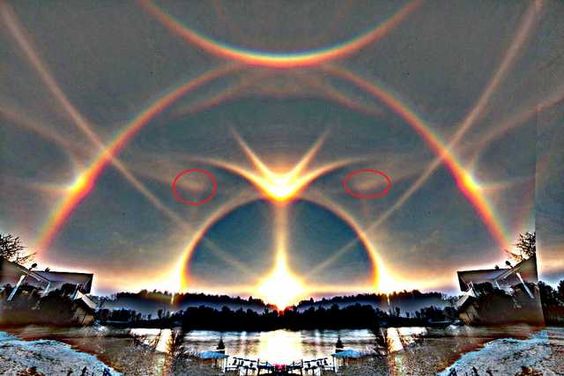Have you ever experienced the awe of taking a winter stroll and discovering the sun accompanied by two brilliant companions? These celestial companions, known as sundogs, manifest as two radiant pillars of light flanking the sun in the winter sky.
A sundog is essentially a concentrated patch of sunlight occasionally seen to the right or left of the sun, or even on both sides simultaneously. Also referred to as mock suns or parhelia, meaning “with the sun,” sundogs are part of a family of atmospheric optical illusions, including moon haloes and sun haloes. These phenomena are all brought about by the refraction of sunlight through ice crystals present in the atmosphere.

Sundogs typically appear as a pair of light patches with subtle colors, positioned at the same altitude over the horizon as the sun. They can take on various forms, resembling vibrant spots or, at times, appearing so intense that they mimic two additional suns in the sky.
The term “sundog” is thought to have roots in Greek mythology, although the exact origin remains elusive. According to some beliefs, as Zeus, the father of all gods and the god of the sky, walked his celestial dogs through the sky, they often appeared as companions to the sun, resembling two “false suns.”

But what gives rise to the formation of sundogs? These celestial phenomena occur when light passes through hexagonal plate crystals of ice suspended in cirrus or cirrostratus clouds, typically at altitudes ranging from 20,000 feet (6,000 meters) to 40,000 feet (12,000 meters).
These ice crystals can also be found closer to the ground in extremely cold climates, where temperatures drop below -22 degrees Fahrenheit (-30 degrees Celsius), a phenomenon known as “diamond dust.”
As these ice crystals descend, their hexagonal faces become roughly horizontal. When rays of sunlight enter through one side edge face and exit through another edge face inclined at 60 degrees to the first, the sunlight deviates by at least 22 degrees, creating a phenomenon known as sun haloes. When the light is concentrated as spots next to the sun, also separated by 22 degrees, it appears as sundogs.


Notably, sundogs often feature “tails” of light stretching out from them, created by the reflection of light from the vertical sides of the flat hexagonal ice crystals. These tails contribute to a canine-inspired appearance to the phenomenon.
Sundogs can also exhibit a sort of rainbow on either side of the sun, with the inner edges closer to the sun displaying a reddish hue, outer edges appearing blue, and middles showcasing yellow or orange tones. This color variation stems from the physics of light, similar to the ordering observed in rainbows.

These atmospheric marvels not only vary in color but also in shape and size, contingent on the size of the ice crystals forming them. These hexagonal crystals rarely remain perfectly horizontal as they descend through the atmosphere, instead wobbling as they fall to Earth, with the amount of wobbling increasing with the crystal’s size.





So, the next time you find yourself on a winter stroll witnessing the sun accompanied by two bright companions, know that you are marveling at the beautiful atmospheric phenomenon of sundogs, brought to life by the refraction of sunlight through ice crystals in the sky.





